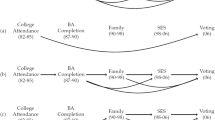Abstract
Using cross-sectional data from 50 states of the United States and the District of Columbia for two different time periods, this paper examines the degree to which special interests or the median voter determine state highway expenditures. In addition to finding that previous estimates of the determinants of state highway expenditures are robust, we find that that special interests that were important in 1984 were no longer significant nearly 20 years later. Like the previous literature, we conclude that the reduced form median voter model performs well in explaining state highway expenditures.
Similar content being viewed by others
References
Ahmed, S., & Greene, K. V. (2000). Is the median voter a clear-cut winner? Comparing the median voter theory and competing theories in explaining local government spending. Public Choice, 105(3–4), 207–230.
Alm, J. (2010). A call for replication studies. Public Finance Review, 38(6), 139–145.
Beaulier, S. A., Hall, J. C., & Lynch, A. K. (2011). The impact of political factors on military base closures. Journal of Economic Policy Reform, 14(4), 333–342.
Becker, G. (1983). A theory of competition among pressure groups for political influence. Quarterly Journal of Economics, 98(3), 371–400.
Congleton, R.D. (2006). The story of Katrina: New Orleans and the political economy of catastrophe. Public Choice, 127(1–2), 127, 5–30.
Congleton, R. D., & Bennett, R. W. (1995). On the political economy of state highway expenditures: some evidence of the relative performance of alternative public choice models. Public Choice, 84(1–2), 1–24.
Council of State Governments. (1987). The Book of the States. Washington: The Council of State Governments.
Council of State Governments. (2013). The Book of the States 2013. Washington: The Council of State Governments.
Gamkhar, S. (2003). The role of federal budget and trust fund institutions in measuring the effect of federal highway grants on state and local government highway expenditure. Public Budgeting & Finance, 23(1), 1–21.
Garrett, T. A., & Sobel, R. S. (2003). The political economy of FEMA disaster payments. Economic Inquiry, 41(3), 496–509.
Goel, R. K., & Nelson, M. A. (2003). Use or abuse of highway tax revenues? An economic analysis of highway spending. Applied Economics Letters, 10(13), 813–819.
Hall, J. C., & Schiefelbein, J. (2011). The political economy of medical marijuana laws. Atlantic Economic Journal, 39(2), 197–198.
Hall, J. C., Nesbit, T. M., & Thorson, R. (2012). The determinants of congressional franking: evidence from the 110th congress. Journal of Applied Economics & Policy, 31(1), 25–34.
Hall, J., Ross, A., & Yencha, C. (2015). The political economy of the essential air service program. Public Choice, 165(1–2), 147–164.
Hersch, J., Rossi, A. F. D., & Viscusi, W. K. (2004). Voter preferences and state regulation of smoking. Economic Inquiry, 42(3), 455–468.
LeSage, J. P., & Dominguez, M. (2012). The importance of modeling spatial spillovers in public choice analysis. Public Choice, 150(3–4), 525–545.
National Right to Work Legal Defense Foundation (2016). Right to work states: dyou work in a right to work state? At: http://www.nrtw.org/rtws.htm.
Oakland, W. H. (1972). Congestion, public goods and welfare. Journal of Public Economics, 1(3–4), 339–357.
Olson, M. (1965). Logic of collective action. Cambridge: Harvard University Press.
Sales and Marketing Management. (1985). Survey of buying power. New York: Sales and Marketing Mangement.
Shughart, W. F., II. (2006). Katrinanomics: the politics and economics of disaster relief. Public Choice, 127(1–2), 31–53.
Sobel, R. S., & Hall, J. C. (2016). Has the war between the rent seekers escalated? Cato Journal, 36(1), 47–53.
Sobel, R. S., Coyne, C. J., & Leeson, P. T. (2007). The political economy of FEMA: did reorganization matter? Journal of Public Finance and Public Choice, 25(2–3), 151–167.
Sutter, D., & Poitras, M. (2002). The political economy of automobile safety inspections. Public Choice, 113(3–4), 367–387.
U.S. Bureau of Labor Statistics. (1984). Employment and wages annual averages. Washington: U.S. Government Printing Office.
U.S. Bureau of Labor Statistics. (2014). Employment and wages annual averages, 2014. Washington: U.S. Government Printing Office.
U.S. Census Bureau. (1980). 1980 Census of population, general social and economics characteristics. Washington: U.S. Government Printing Office.
U.S. Census Bureau. (1987). Statistical abstract of the United States, 1987. Washington: U.S. Government Printing Office.
U.S. Census Bureau. (2010). State area measurements and internal point coordinates. Washington: U.S. Government Printing Office.
U.S. Census Bureau. (2014). Current population survey. Washington: U.S. Government Printing Office.
U.S. Department of Agriculture. (2012). 2012 Census of agriculture. Washington: National Agriculture Statistics Service.
U.S. Department of Transportation. (1985). Highway statistics 1985. Washington: U.S. Government Printing Office.
U.S. Department of Transportation. (2013). 2013 State Statistical Abstracts Highway Statistics Series. Washington: U.S. Government Printing Office.
Walden, M. L., & Eryuruk, G. (2012). Determinants of local highway spending in North Carolina. Growth and Change, 43(3), 462–481.
Author information
Authors and Affiliations
Corresponding author
Appendix
Appendix
Rights and permissions
About this article
Cite this article
Hall, J., Pokharel, S.B. Does the Median Voter or Special Interests Determine State Highway Expenditures? Recent Evidence. Atl Econ J 45, 59–69 (2017). https://doi.org/10.1007/s11293-016-9523-5
Published:
Issue Date:
DOI: https://doi.org/10.1007/s11293-016-9523-5




